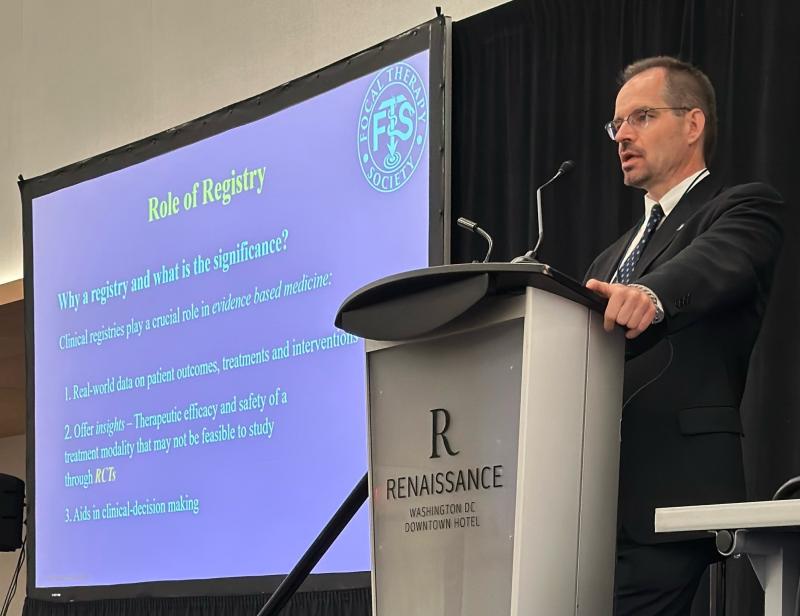
The Focal Therapy Society recently held its 13th International Symposium from September 7-9, 2023, in Washington, DC. The symposium was highly successful, bringing together experts and enthusiasts in the field and providing them with a platform to exchange ideas.

The highlights of the symposium include organizing an FDA session on focal therapy approval, which was followed by an open discussion with an FDA panel. Additionally, there were state-of-the-art plenary talks and discussions on various topics such as genomic profiling, advanced imaging techniques, and precision medicine approaches in the management of prostate and kidney cancer using focal therapy by 70 internationally renowned experts in the field over the period of three days.
The symposium concluded with closing remarks from Duke Urology's Dr. Thomas J. Polascik, who also extended an invitation to participate in the upcoming 14th International Symposium scheduled to take place in Singapore in 2024.
Duke University's Faculty Involvement
Thomas J. Polascik, MD, FACS, Professor of Urology and Radiology, Director of the Focal Therapy Program at the Duke Cancer Institute
Dr. Polascik is widely recognized as an expert in cryoablation, a specialized focal therapy technique used for the treatment of localized prostate cancer. He began the symposium with a "presidential address" discussing the accomplishments of the Focal Therapy Society over the past several years and shedding light on future goals. He delivered an outstanding presentation on the purpose of the FTS registry, its role in evidence-based medicine, and its significance in establishing the objective of the Focal Therapy Society. He gave a status report on the FTS registry following its inception in 2019 which was well received by delegates and many expressed their eagerness to contribute to it. Next, he delivered his third talk on "Getting involved with Focal Therapy Society Committees." During this discussion, he emphasized the benefits of becoming a member of the society and highlighted how working together could help individuals achieve their goals, which was warmly welcomed by the audience
Cary N. Robertson, MD, FACS, Professor of Urology at Duke Cancer Institute
Dr. Robertson specializes in high-intensity focused ultrasound (HIFU), a targeted therapy method used to treat localized prostate cancer. He delivered a presentation discussing the benefits of utilizing "contrast-enhanced ultrasound (CEUS) in HIFU" and how it enhances the effectiveness of focal therapy. He moderated the hands-on section in HIFU and provided explanations on the technical aspects that will enhance the oncological and functional outcomes in HIFU.
Rajan T. Gupta, MD, Professor of Radiology and Urology, Chief of Abdominal Imaging at the Duke Cancer Institute
Dr. Gupta possesses expertise in utilizing advanced imaging techniques such as mpMRI to detect and characterize prostate cancer. He co-presented a talk and moderated an interactive learning course on mpMRI interpretation and MRI-TRUS fusion in cryoablation of prostate cancer alongside Dr. Polascik. The discussion revolved around the operative techniques and technical challenges involved in interpreting the mpMRI images after cryoablation. It was an insightful and well-discussed topic. Dr. Gupta delivered his second presentation on the significance of implementing a multidisciplinary protocol for quality improvement in managing discordant fusion biopsy results with prostate MRI lesions. During the discussion, he highlighted the scholarly work conducted by Duke University's Urology and Radiology departments in the development of the Quality Improvement (QI) protocol. He emphasized how the implementation of this protocol will enhance the management of patients diagnosed with prostate cancer. Following that, he gave a presentation on their recent research in Prostate Imaging-Reporting and Data System (PI-RADS) 4 heterogeneity in prostate cancer. Dr. Gupta explained the significance of sub-categorizing PI-RADS 4 and how it provides additional detail by identifying the lesions that truly warrant greater suspicion for cancer.
Kathryn R. Nightingale, PhD, Theo Pilkington Distinguished Professor of Biomedical Engineering
Dr. Nightingale aims to research and enhance ultrasonic imaging techniques for the diagnosis and treatment of prostate cancer. She delivered an outstanding presentation on our joint efforts in developing innovative acoustic radiation force impulse (ARFI)-based elasticity imaging techniques for visualizing the mechanical characteristics of tissues. The audience highly praised her work on developing multiparametric ultrasound and its role in diagnosing prostate cancer, especially in comparison to multiparametric MRI.

About the Focal Therapy Society
The beginnings of the society can be traced back to 2008 with the aim of treating localized prostate and kidney cancer in a minimally invasive manner while sparing the non-malignant portions of the organ. The goal is to achieve excellent functional outcomes and reduce morbidity, all while maintaining effective oncological control.
The Focal Therapy Society’s founding executives are led by Drs. Thomas J. Polascik (Founding President), Jean de la Rosette, Rafael Sanchez-Salas and Ardeshir Rastinehad. In October 2019, the Focal Therapy Society was officially incorporated and partnered with the Endourological Society.
From the time of its establishment, the society has achieved significant success through its international recognition and continued to grow stronger with support from 300 members. The society includes international experts who share a common ambitious goal: to ensure the success of image-targeted focal therapy. This diverse group includes urologists, radiologists, radiation oncologists, medical oncologists, pathologists, biomedical engineers, as well as professionals from the pharmaceutical and device industries.
Since its inception, the society has been organizing an international symposium on focal therapy and imaging in prostate and kidney cancer. The symposium was held in North America, Europe, and Japan on a rotating basis.